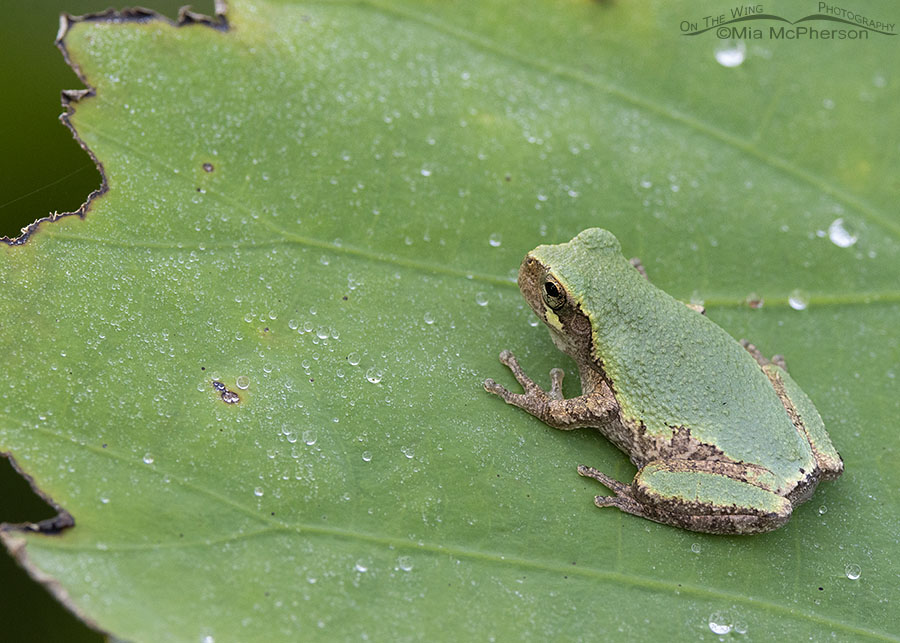This morning I am sharing a simple photo of an adult Gray Treefrog on a lotus leaf taken at Sequoyah NWR. Or is it so simple? Maybe it is more complex.
 Adult Gray Treefrog on a lotus leaf – Canon R7, f11, 1/100, ISO 800, -1.0 EV, Canon 100-500mm at 500mm, natural light
Adult Gray Treefrog on a lotus leaf – Canon R7, f11, 1/100, ISO 800, -1.0 EV, Canon 100-500mm at 500mm, natural light
Thus far, this is one of my better images of this tree frog species. I’ve photographed them before at Sequoyah National Wildlife Refuge in Oklahoma. I wasn’t satisfied with those photos because they were taken with my Nikon D810 with a 70-300mm lens attached.
The 300mm lens simply didn’t provide enough reach to get the images I wanted of these tiny tree frogs.
When I brought my D500 with a 500mm lens to this spot, it was heavy, and the frogs were too close for me to focus on.
But by using Steve Creek’s Canon R7 and his RF 100-500mm attached yesterday, I was able to get photos of this tiny Gray Treefrog that I am happy with.
The minimum focusing distance on that zoom lens is much shorter than it is on my Nikkor 500mm lens and that enabled me to as close to the frog as I could, or maybe as close as I needed.
Now to the “complex” stuff about this treefrog.
Technically, I believe that this is considered a Gray Treefrog Species Complex.
Huh? What does that mean?
The Gray Treefrog Species Complex refers to two closely related species of treefrogs that are nearly identical in appearance but genetically distinct: the Gray Treefrog (Hyla versicolor) and Cope’s Gray Treefrog (Hyla chrysoscelis)[1][2][3]. These species are considered “cryptic” because they are visually indistinguishable from each other, making identification challenging without specialized methods[2][3].
Key features of the Gray Treefrog Species Complex include:
1. Genetic Difference: The main distinction between the two species is their chromosome count. Hyla chrysoscelis is diploid (two sets of chromosomes), while Hyla versicolor is tetraploid (four sets of chromosomes)[1][2].
2. Call Differences: The mating calls of the two species differ, with Cope’s Gray Treefrog having a faster trill rate compared to the Gray Treefrog[1][2]. This is one of the primary ways to distinguish between the species in the field.
3. Overlapping Ranges: Both species can be found in many of the same areas across the eastern United States, though there are some regions where only one species occurs[2][3].
4. Physical Similarities: Both species are medium-sized frogs (up to 6 cm SVL) with similar coloration and markings, including a black star-shaped or irregular X-shaped blotch on the back and orange or yellow patches in the groin and inner thigh[1][4].
5. Taxonomic History: The complex has a complicated taxonomic history due to the difficulty in distinguishing between the species, leading to considerable confusion in early reports and distributions[2][3].
The term “species complex” is used because these two species are so closely related and similar that they were once considered the same species. Their distinction highlights the importance of genetic and behavioral factors in species classification, beyond just physical appearance.
For the sake of my brain cells, I’m calling this a Gray Treefrog and removing, or maybe avoiding, some of the complexity.
Life is good.
Mia
Check out my reptile and amphibian photos in their galleries.
Citations:
[1] https://herpetology.inhs.illinois.edu/species-lists/ilspecies/gray-treefrog-complex/
[2] https://www.virginiaherpetologicalsociety.com/amphibians/frogsandtoads/gray-treefrog/index.php
[3] https://www.virginiaherpetologicalsociety.com/amphibians/frogsandtoads/copes-gray-treefrog/index.php
[4] https://www.herpingva.org/profiles/gray-treefrog-complex-hyla-versicolor-chrysoscelis
[5] https://askanaturalist.com/copes-tree-frog-or-gray-tree-frog/


We have a patio frog that visits us every year. He lives in and under my flower boxes, sits on my deck and climbs my umbrella poll.
The pic is fascinating; the detail is incredible and I love your informative and interesting narrative. Thanks Mia.
Wonderful image. I am both admiring your new adventures and jealous of the all the wonderful wildlife you are seeing, many I have never even heard of! Many happy new adventures to you!
Love seeing the path of evolution where its back looks like tree bark. Nice pic Mia
Nice pic of frog….
.